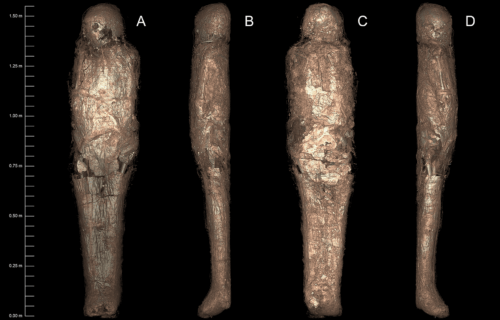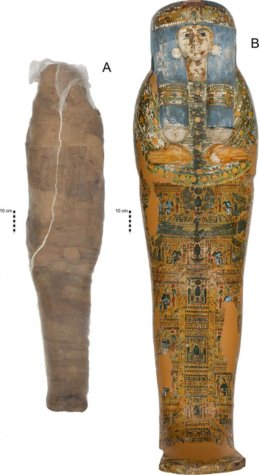
Fig 4. 3D-rendered CT images of mummified individual (NMR.27.3) showing the carapace and broken sections (stitched image). A. Anterior. B. Lateral left-hand side. C. Posterior. D. Lateral right-hand side. (Courtesy Chau Chak Wing Museum and Macquarie Medical Imaging).
DECEMBER 12, 2021
by Study Finds
SYDNEY — British philanthropist Sir Charles Nicholson bought a mummified body, lidded coffin, and mummy board as a set during a trip to Egypt in the 1850s, before donating it to the University of Sydney in Australia in 1860. The coffin’s inscription identifies the owner as a titled woman named Meruah, and the iconography dates the sarcophagus to around 1000 BC. However, new analysis using state of the art technology reveals that although the body is that of a female aged 26 to 35 years old, it is actually much older than the coffin.
Dr. Karin Sowada, of Macquarie University in Australia, and her colleagues describe their discovery of a rare painted mud shell enclosing the mummy — called a “carapace” — in Sydney’s Chau Chak Wing Museum. Although the mummified individual underwent a CT scan in 1999, Dr. Sowada and her team rescanned the body using updated technology. Visualization of the dentition and skeleton determined that the mummified remains were of a woman who lived to be about 26 to 35 years old.
“The mud shell encasing the body of a mummified woman within the textile wrappings is a new addition to our understanding of ancient Egyptian mummification,” Dr. Sowada explains in a statement.
Researchers say there was no signs of external genitalia on the body, and its reproductive organs were likely removed during the mummification process. Instead, they used the individual’s hip bones, jaw and cranium to confirm she was female. Analysis of the linen wrappings covering the body show she lived in the late New Kingdom, around 1200 BC to 1113 BC.
DECEMBER 12, 2021
by Study Finds
SYDNEY — British philanthropist Sir Charles Nicholson bought a mummified body, lidded coffin, and mummy board as a set during a trip to Egypt in the 1850s, before donating it to the University of Sydney in Australia in 1860. The coffin’s inscription identifies the owner as a titled woman named Meruah, and the iconography dates the sarcophagus to around 1000 BC. However, new analysis using state of the art technology reveals that although the body is that of a female aged 26 to 35 years old, it is actually much older than the coffin.
Dr. Karin Sowada, of Macquarie University in Australia, and her colleagues describe their discovery of a rare painted mud shell enclosing the mummy — called a “carapace” — in Sydney’s Chau Chak Wing Museum. Although the mummified individual underwent a CT scan in 1999, Dr. Sowada and her team rescanned the body using updated technology. Visualization of the dentition and skeleton determined that the mummified remains were of a woman who lived to be about 26 to 35 years old.
“The mud shell encasing the body of a mummified woman within the textile wrappings is a new addition to our understanding of ancient Egyptian mummification,” Dr. Sowada explains in a statement.
Researchers say there was no signs of external genitalia on the body, and its reproductive organs were likely removed during the mummification process. Instead, they used the individual’s hip bones, jaw and cranium to confirm she was female. Analysis of the linen wrappings covering the body show she lived in the late New Kingdom, around 1200 BC to 1113 BC.
Mummified individual and coffin in the Nicholson Collection of the Chau Chak Wing Museum, University of Sydney. A. Mummified individual, encased in a modern sleeve for conservation, NMR.27.3. B. Coffin lid, NMR.27.1. (Published under a CC BY license, with permission from the Chau Chak Wing Museum, original copyright 2019).
So how could it be the that body could be older than the actual sarcophagus? Researchers believe that 19th century dealers who were selling the ancient Egyptian coffin placed an unrelated body inside so that it appeared to be a complete set.
“The new scans also revealed the extent and nature of the mud carapace, showing the mud shell fully sheaths the body and is layered within the linen wrappings. Images of the inmost layers indicate the body was damaged relatively shortly after initial mummification, and the mud carapace and additional wrappings were applied to reunify and restore the body,” explains Dr. Sowada.
In addition to its practical restorative purpose, the researchers suggest the mud carapace gave those who cared for the deceased the chance to emulate elite funerary practices of the time. This included coating the body in an expensive imported resin shell using cheaper, locally available materials.
Since this mud carapace treatment has not been previously documented, the team noted that it isn’t possible to determine how frequent the treatment may have been for non-elite mummies in the late New Kingdom of ancient Egypt. They suggest that further radiological studies on other non-royal mummies may reveal more about the practice.
These findings are published in the journal PLOS One.
SWNS writer Stephen Beech contributed to this report.
So how could it be the that body could be older than the actual sarcophagus? Researchers believe that 19th century dealers who were selling the ancient Egyptian coffin placed an unrelated body inside so that it appeared to be a complete set.
“The new scans also revealed the extent and nature of the mud carapace, showing the mud shell fully sheaths the body and is layered within the linen wrappings. Images of the inmost layers indicate the body was damaged relatively shortly after initial mummification, and the mud carapace and additional wrappings were applied to reunify and restore the body,” explains Dr. Sowada.
In addition to its practical restorative purpose, the researchers suggest the mud carapace gave those who cared for the deceased the chance to emulate elite funerary practices of the time. This included coating the body in an expensive imported resin shell using cheaper, locally available materials.
Since this mud carapace treatment has not been previously documented, the team noted that it isn’t possible to determine how frequent the treatment may have been for non-elite mummies in the late New Kingdom of ancient Egypt. They suggest that further radiological studies on other non-royal mummies may reveal more about the practice.
These findings are published in the journal PLOS One.
SWNS writer Stephen Beech contributed to this report.

No comments:
Post a Comment